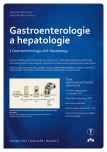Reflection on the financial aspects of caring for patients with colorectal carcinoma
Authors:
J. Špičák
Authors‘ workplace:
Klinika hepatogastroenterologie, IKEM, Praha
Published in:
Gastroent Hepatol 2012; 66(5): 340-344
Category:
Gastrointestinal Oncology: Review Article
Overview
Evaluation of the economics of care for patients with colorectal cancer is difficult because of the plethora of related changeable factors. The average length and quality of oncological care are increasing together with expenditures on the rising number of surviving oncological patients. In the USA, the costs of oncological care will increase by 27% by 2020, while the implementation of biological treatment prolongs survival by only 1.4 month. In Ireland, the costs of chemotherapy increased in the years 1994–2002 by more than two times. In Germany, expenditures on colorectal cancer care increased between 2002 and 2006 by 21.1%. The costs of chemotherapy increased by 33%. For the implementation of a screening programme, the capacity of endoscopic units is important. In the USA, more than 2.5 times more colonoscopies compared to the Czech Republic are performed, while in the Netherlands the number is lower. Here, an organized screening programme has recently been implemented based on FIT at two-year intervals and on colonoscopy. Gradual involvement of all the target population over 50 years of age is presumed with an increase in the number of colonoscopies of 50%. The comprehensive costs of screening are remarkable, the least costly being programmes based on TOK and sigmoidoscopy. Screening is clearly financially more advantageous than not implementing it and having to treat patients in advanced stages. It is also less costly in comparison with other screening programmes. Oncological care in the CR is under-funded and the whole system is financially efficient. Surgical care is relatively the most under-funded type of care.
Key words:
colorectal neoplasms – cost-benefit analysis
The author declares he has no potential conflicts of interest concerning drugs, products, or services used in the study.
The Editorial Board declares that the manuscript met the ICMJE „uniform requirements“ for biomedical papers.
Submitted:
27. 8. 2012
Accepted:
30. 8. 2012
Sources
1. Mariotto AB, Yabroff KR, Shao Y et al. Projections of the cost of cancer care in the United States: 2010–2020. J Natl Cancer Inst 2011; 103(2): 117–128.
2. Karaca-Mandic P, McCulloough JS, Siddiqui MA et al. Impact of New Drugs and Biologics on Colorectal Cancer Treatment and Costs. J Oncol Pract 2011; 7(3S): e30s–e37s.
3. Bending MW, Trueman P, Lowson KV et al. Estimating the direct costs of bowel cancer services provided by the National Health Service in England. Int J Technol Assess Health Care 2010; 26(4): 362–369.
4. Tilson L, Sharp L, Usher C et al. Cost of care for colorectal cancer in Ireland: a health care payer perspective. Eur J Health Econ 2012; 13(4): 511–524.
5. von der Schulenburg JM, Prenzler A, Schurer W. Cancer management and reimbursement aspects in Germany: an overview demonstrated by the case of colorectal cancer. Eur J Health Econ 2010; 10 (Suppl 1): S21–26.
6. Seeff LC, Manninen DL, Dong FB et al. Is there endoscopic capacity to provide colorectal cancer screening to the unscreened population in the United States? Gastroenterology 2004; 127(6): 1661–1669.
7. Pignone M, Saha S, Hoerger T et al. Cost-effectiveness analyses of colorectal cancer screening: a systematic review for the U.S. Preventive Services Task Force. Ann Intern Med 2002; 137(2): 96–104.
8. Lansdorp-Vogelaar I, Knudsen AB, Brenner H. Cost-effectiveness of colorectal cancer screening. Epidemiol Rev 2011; 33(1): 88–100.
9. Telford JJ, Levy AR, Sambrook JC et al. The cost-effectiveness of screening for colorectal cancer. CMAJ 2010; 182(12): 1307–1313.
10. Larsson DR, DiCarlo M, Myers RE et al. Cost-effectiveness of targeted and tailored interventions on colorectal cancer screening use. Cancer 2008; 112 : 779–788.
11. Heitman SJ, Hilsden RJ, Au F et al. Colorectal cancer screening for average-risk North Americans: an economic evaluation. PLoS Med 2010; 7(11): e1000370.
12. Frič P, Zavoral M, Dvořáková H et al. An adapted program of colorectal cancer screening – 7 years experience and cost-benefit analysis. Hepatogastroenterology 1994; 41(5): 413–416.
13. Wohl P, Bednarik M, Wohl P et al. Comparison of various strategies for colorectal cancer screening tests. Eur J Gastroenterol Hepatol 2011; 23(12): 1157–1164.
Labels
Paediatric gastroenterology Gastroenterology and hepatology SurgeryArticle was published in
Gastroenterology and Hepatology

2012 Issue 5
- Metamizole vs. Tramadol in Postoperative Analgesia
- Metamizole at a Glance and in Practice – Effective Non-Opioid Analgesic for All Ages
- Metamizole in perioperative treatment in children under 14 years – results of a questionnaire survey from practice
- Possibilities of Using Metamizole in the Treatment of Acute Primary Headaches
- Spasmolytic Effect of Metamizole
Most read in this issue
- Budenofalk 2 mg rectal foam represents a major new option in the treatment of patients with ulcerous colitis
- Epidemiology of malignant tumours of the gastrointestinal tract in the Czech Republic – state of the art and prediction
- Pancreatic cancer
- Prof. MUDr. Aleš Hep, CSc., turned 60
